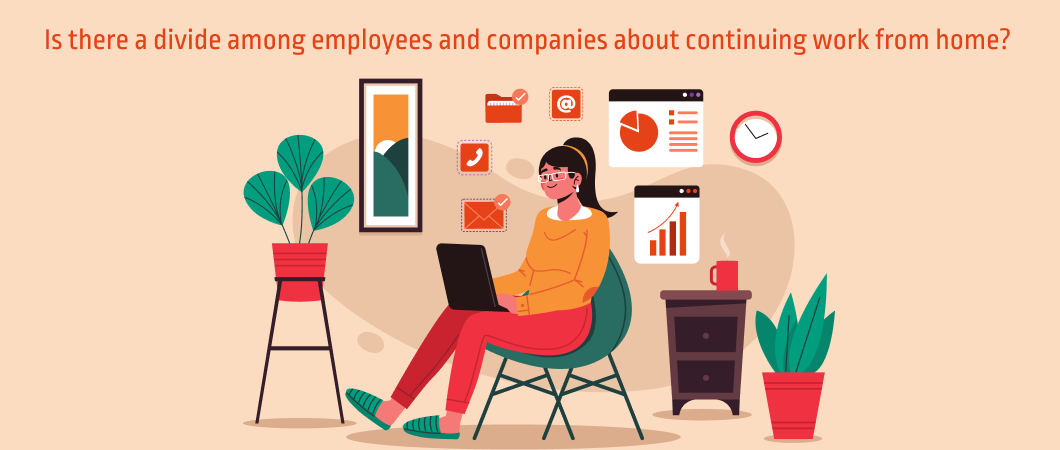At the time of writing this article, the notion of a hybrid workplace is no longer the “New Normal”. It’s the “Now Normal”! The search term “hybrid work” is scoring between 90 and 100 (peak of popularity) on Google Trends. Statista is touting the closely associated market of collaboration software to reach $17.9 billion by 2025. Gartner is warning about a possible 39% attrition rate for companies that seek a “hard return” to the office. McKinsey is furthering the narrative of remote work through surveys like this where 87% of the employees seem inclined towards location-agnosticism.
The workforce today thrives on the freedom to work from anywhere, anytime. But is there a clear understanding of what a hybrid workplace might look like in the future?
What will be the new rules of engagement? What old and trusted methods will have to be jettisoned? What kind of new office configurations will arise from these shifts? Will technology be the catalyst for a new type of workplace? And perhaps most crucially, will employees ever want to come back to the office? And for what?
These questions require us to look over the horizon to explore the nature of hybrid work itself.
The Hybrid Workplace of 2022 and Beyond
Three key elements – replacing, transforming, and collaborating – seem to merit the most attention in the hybrid workplace.
Replacing the Workplace
The first aspect to consider is that of replacing the traditional office. The experience of working from home might differ for different demographics, but the general gist is that many people now feel more comfortable and at ease working from anywhere, especially other than in the traditional office setting.
Just to lend a little bit of perspective as to why people want to stay put, look at the opinions members of our team shared in a survey we did. A majority of them wanted to spend no more than 20 minutes on a one-way trip to work. It would seem that the commute has a more significant influence than the workday itself on the inclination towards a remote or a hybrid culture.
So, how to go about “replacing” the workplace?
If shorter commutes are what the workforce desires, we can take steps to strategically locate office spaces across town (or towns?) to minimize travel times. Multiple co-working spaces could take on the role of hubs to accommodate those who wish to work flexibly. The appropriate amount of space, equipped with concentration zones, can provide a healthy blend of work and socialization. Obviously, we need to equip the space to be conducive enough for productivity.
Transforming the Workflow
“To make hybrid a success, you have to consider how work gets done,” writes Lynda Gratton on Harvard Business Review. You need to consider the way we go about accomplishing that and how and where we take our time-outs. In a hybrid setting, we must explore how to incorporate the best of both worlds into one experience.
Technology is sure to play a role and powerful solutions are already appearing. A great example is ServiceNow’s Workplace Service Delivery, which has been explicitly designed to enable “return to office”. The solution facilitates real-time reservations and allocation of spaces, visitor registrations, and 360 degrees of visibility into how the workplace looks like and what cases are being handled by the employees at a given point in time.
Such solutions will influence, or maybe reshape, workflows and drive a rise in workplace amenity. Transforming the workflows would entail:
- Adapting the workplace to suit the needs of remote workers
- Creating consistency of experiences irrespective of employee location – on-premise or offsite
- Improving how information is shared and distributed
- Navigating the delivery of services through better automation.
- Implementing analytics to measure the impact of certain workflows, and then implementing it, etc.
Collaborating Differently
How people choose to work may also change. For instance, people may want to work for specific teams akin to how they have been inclined to work with particular managers. That’s because the dynamics of collaboration are transitioning from the hierarchy we’ve been used to. Collaboration is set to be more “horizontal” than ever before.
This effectively translates to distributed and in-house teams stepping up, as semi-organized clusters of individuals embrace collaboration as a way of working. Realistically, this means:
- Hiring people with high adaptability and even better collaboration skills
- Using tools to establish and reinforce collaboration practices
- Increasing collaboration through different methods, such as virtual meets, retrospectives, and gamification.
- Moving towards an environment that caters to the learning and growth needs of employees
- Adopting a culture whereby people are encouraged to take ownership in their projects
- Lining up with similar individuals in key roles to facilitate collaboration around key tasks.
Wrapping Up
A couple of years ago, prevailing conditions imposed restrictions on in-office work and pushed employees to remote working. Today, organizations are finding it difficult to recall them to the office and are moving back and forth between the two, depending on a situation’s demands — all while keeping a lid on our colleagues’ remote work hours.
In the years to come, we might find ourselves in a similar predicament. We might feel that working from the office isn’t always necessary, but we’ll also find ourselves feeling nostalgic for the traditional office, which will be fondly associated with socialization as much as it is with work.
With that, we need to ask ourselves how it is that we’re going about collaboration and how we can improve it for the better. Moreover, what does it mean for the current and the future workplace to be “hybrid”?



